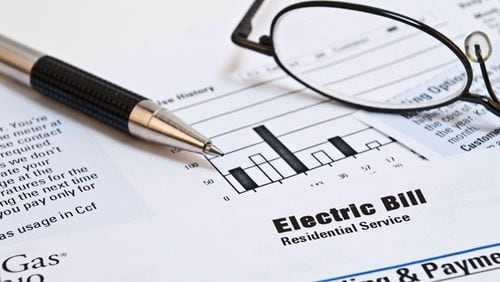When his oldest daughter was accepted to Georgia State University, Gene Byce was thrilled she would be attending his alma mater. So he began looking for apartments for her close to campus.
He ended up buying a condo in the historic William Oliver building, Atlanta’s first art deco skyscraper, on Peachtree Street at Five Points, in 2020. The mortgage worked out to less than he would have paid for a dorm and meal plan, he said.
Three years later, when his youngest daughter also decided to enroll at GSU, he did the same thing all over again. To head off any sibling conflict, Byce made sure the units were almost identical in square footage. His daughters loved the building — they were close to campus and both wanted to continue living there after graduation.
Condo living was going well until January, when Byce was hit with an electric bill for one unit that was more than double the bill for the other unit. Both units had previously used about 580 kilowatt hours. Now one had jumped to 1531, an amount comparable to the electricity usage at his Gwinnett County ranch home, which has a basement and a commercial woodworking shop.
Byce called his oldest daughter and asked if she was forgetting to turn off the lights or doing anything out of the ordinary. They experimented with ways to conserve energy, but nothing they tried made a difference. He contacted the building manager, the homeowner’s association and Conservice, the company that manages utility billing at the property. No one could explain what was happening.
“I was getting the runaround — all the way around,” Byce told me.
Determined to get to the bottom of the problem, he contacted an electrician, who said everything looked fine. Then he attached an electric usage monitor to the breaker panel. And he says that’s when he discovered what he suspected all along — the actual average usage in his daughter’s condo was between 580 to 600 kWh, about the same as her sister’s. What he still doesn’t know is how two units that are the same size have such different kWh readings.
“No one can give me a straight answer,” he said. He stopped autopay and began paying only for the usage based on his own measurements. He wants a refund for the months he believed he was overcharged.
If this story sounds familiar, that’s because it is. I wrote a similar story about a year ago. Different resident, different building, same third-party biller, Conservice. Since I wrote that first story, I have received emails from residents all over metro Atlanta — Sandy Springs, Canton, southeast Atlanta — all asking me to take a closer look because they couldn’t get any answers from the company.
I did, and I’ll share what I learned. But first, I want to be clear about why I am writing this column. It’s because I don’t think it should ever get to the point where residents are forced to meter their own electricity or water or gas to prove there is a problem. And when there is a problem, they should be able to get an answer.
Utility costs at multi-unit buildings are allocated to residents by billing them based on actual usage or estimated usage. Actual usage is read from individual meters (sub meters) attached to every unit in a building. If buildings do not have sub meters, building managers must estimate the cost of utilities.
Many buildings use the Ratio Utility Billing System (RUBS), which divides the total cost of water, gas or electricity between residents based on an industry formula.
RUBS is not as accurate as an actual meter reading, but it saves property owners the expense of installing and maintaining meters on every unit.
But it can also leave too much room for interpretation. As one reader put it, “I am beginning to wonder if sub-billing master utility accounts is just another predatory business with no safe haven.”
Reader, I am beginning to wonder the same.
When I asked Conservice about Byce’s concerns, a representative said they were pulling historical data to determine what was going on. The rep told me that when utility bills are consistently high, that could indicate an increase in utility rates. When utility bills fluctuate, that could indicate a change in weather. That’s a standard response.
The rep told me Conservice does a rate analysis when bills come in to see if there are anomalies. Then they work with utility companies to resolve any problems. The customer service team fields about 100,000 calls a month, but some issues just take time to resolve, the representative said.
Maybe then, the solutions have to come from somewhere else.
In 2012, Georgia was the first state to enact laws that mandated individual metering in multi-tenant buildings. But that requirement only applies to water — not electricity, gas or other utilities.
If that requirement were extended to all utilities, maybe It would create the safe haven that some Georgians are seeking.
And residents like Byce wouldn’t have to take matters into their own hands.
Read more on the Real Life blog (www.ajc.com/opinion/real-life-blog/) and find Nedra on Facebook (www.facebook.com/AJCRealLifeColumn) and Twitter (@nrhoneajc) or email her at [email protected].








